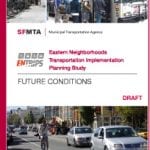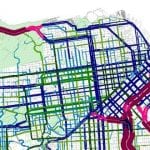The SFCTA has released a draft Strategic Analysis Report about employer owned shuttle services in San Francisco. There are two types of shuttles being used in San Francisco – large shuttles (“Regional employer shuttles”) that transport San Francisco residents to the Silicon Valley, and smaller shuttles (“Local employer/circulator shuttles”) that pick people up from CalTrain and BART, bringing them to work in SoMA.
The SFCTA has gathered data about the use of these private shuttles in the city in order to create a set of policy recommendations about their usage. The policies are intended to mitigate problems that have arisen due to the shuttles – noise and safety, loading area vehicle conflicts, double parking, etc. – while also maintaining the many benefits they provide.
These benefits have been studied thoroughly and quantified in the TA’s report. The shuttles reduce the amount of car trips to Silicon Valley by about one third of a million trips per year, improving the local environment, quality of life, and the transportation systems effectiveness. The report methodology also included surveys and interviews to flesh out various perspectives and experiences with shuttle services. Many of the people who use these shuttles say they live car free because of the service, and 14% say they would leave their current employer if the shuttles weren’t offered. Local businesses near the shuttle stops also report that they receive more customers because of people waiting for the shuttles.
Although there are many benefits associated with these shuttles, the report calls out a few problems they cause as well.
Problems
The large shuttles heading south have several problems:
They are too big for the small residential streets they operate on
blocking traffic, pedestrian sight lines
they are loud and cause vibrations
eroding the streets and curbs
They block MUNI bus stops
They have long loading and idling times.
The smaller shuttles:
Are rarely full
Eleven independent shuttle services.
Policy Solutions
The report concludes with a number of policy recommendations.
For the larger regional shuttles:
The MTA should have more oversight over the shuttles routes and stops
Best practices recommend that the MTA should use its enforcement of specialized curb zones and the shared bus stop policies to influence shuttle routes.
The local employer shuttles:
The MTA could take over some of these routes
The diverse shuttles services should combine into centralized entity, funded by the businesses with oversight by the MTA.
This shuttle services SAR will be presented to the Transportation Authority Board’s Plans and Program Committee in December or early January. Visit the TA website for more specific information on next steps in the process.






